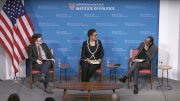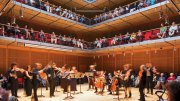“Almost everything that we have,” said legal scholar and civil rights attorney Gloria Browne-Marshall during a Tuesday evening event at the Harvard Kennedy School (HKS), “somebody had to protest for us to have it.” She gestured toward the multi-racial crowd sitting in front of her. “For us to be in this room, with this very diverse audience, people had to protest for this,” she said. “And I think we got disconnected from the large and small ways in which people have protested.”
A constitutional law scholar at John Jay College of Criminal Justice in New York, Browne-Marshall is the author of A Protest History of the United States, due out next month from Beacon Press. She shared the stage on Tuesday with Hauser professor of the practice of nonprofit organizations Cornell William Brooks and Stanton professor of the First Amendment Erica Chenoweth (who served as moderator). The event’s title—“What Is an Effective Protest Today?”—read as a plaintive question, amid the convulsions caused by the Israel-Gaza war and by the early actions of new Trump administration.
In winding toward an answer, the panelists talked about mentors and money, and the importance of good leadership and of participants’ willingness to fill whatever roles need filling: as organizers and strategists, but also lawyers, teachers, financial backers, foot soldiers, bus drivers. The definition of protest is equally broad. “It’s not just going out in the street, raising your fist, and having the bullhorn,” Browne-Marshall said: it’s also writing and reading, especially in an era of book bans. And it is teaching forbidden subjects. “When they’re telling you that the subject of race and the law—my subject that I specialize in—is against the law, you teach it anyway,” she said. “There are so many ways in which people protest.” Strikes, boycotts, mutual aid, symbolic displays of resistance and noncompliance—successful protest includes all of these. “Rosa Parks didn’t have a bullhorn,” Browne-Marshall reminded the audience. “She did something very simple by just staying seated.”
Panelists also talked about the history of protest, which Browne-Marshall’s book traces back to the indigenous people who began resisting European encroachment in North America during the 1500s. And turning to contemporary protest, they discussed the benefits and drawbacks of “leaderless” movements, which have grown more popular during the past 15 years. “They’re less vulnerable in terms of political decapitation, having one leader who can be taken out,” said Brooks, a former NAACP president. Leaderless movements also tend to be more democratic and less patriarchal, with a lower barrier to entry for those who want to join. But, he added, “These flat movements, they’re more vulnerable to delegitimization and criminalization.” Without dedicated financial officers, donation money can be stolen or mishandled (Brooks did not cite specific examples, but several members of Black Lives Matter organizations have gone to jail or been sued for fraud). “And when you have movements that are discredited,” Brooks said, “that’s a problem.”
The group spent some time dissecting what seems to be missing from protests today. “Where is the music? Where is the fun?” Browne-Marshall asked. “Where is this standing shoulder to shoulder together in a common cause? That is something that stays with you for your lifetime…. All these things that are part of the movement, my concern is we’ve outsourced those things.” These days, she said, too many people “think somebody else is supposed to do the protesting, someone else is supposed to do the work, and I’m going to live my life, because I don’t want to be outside in the cold. I don’t want to risk my scholarship. I don’t want to risk being arrested.”
She and Brooks laid this issue partly at the feet of elder leaders who failed to train young protesters coming up behind them. “I have to chastise the older generations,” she said, meaning civil rights era leaders, “who didn’t train us on protest, because they actually thought we wouldn’t have to go through this again.” Brooks recalled the work of singer and activist Harry Belafonte, who continued mentoring new generations of protesters—and protesting alongside them—right up until his death in 2023 at 96 years old. But Belafonte’s example is rare. “How is it that in this moment right now, we have these movements where we have engaged in a kind of intergenerational abdication of responsibility?” Brooks asked. “We say, ‘Let the young people do this.’ That is generationally irresponsible. We need to support young leaders.”
During the audience Q&A, a graduate student pressed this point even more directly. Recalling last year’s pro-Palestine demonstrations and encampment on campus, she said she had felt like an “orphaned protester” without much vocal support or guidance from faculty members, even as she and her fellow demonstrators were being “demonized” for their actions. “Where are the mentors?” she asked, echoing Brooks.
More than once, the conversation circled around to the question of violence. At one point Browne-Marshall asked Chenoweth, who directs the Nonviolent Action Lab at HKS and is an expert in both political violence and nonviolent resistance, about whether peaceful protest can succeed without facing any violence. The answer: not really. “Movements that actually seriously challenge the status quo are almost always targeted with violence from their opponents,” Chenoweth said, “and this is such a prominent finding that it’s almost a social science law.” What’s important, and more within activists’ control, is understanding how to exploit that violence so that it backfires against those who use it. “[Martin Luther] King and his colleagues were very aware,” Chenoweth said, “of the ways in which the interaction between mass media and the violence that was being visited upon nonviolent marchers in Selma and elsewhere were going to help the movement make its point.”
An undergraduate audience member returned to the topic a few minutes later. “It’s a little bit taboo, especially nowadays,” the student conceded, but still, he wondered: is there a role for violence in successful protest movements? Browne-Marshall, whose book includes a chapter on violent protest (“because not everyone believed in nonviolent protests”), answered first. “One thing that Martin Luther King said: if you’re going to use violence in this country that believes in violence anyway, you’re not going to win. There are more guns than people in this country, and the people who have those guns do not care about those people who are protesting.”
Brooks, meanwhile, spoke about the effectiveness not of violence itself, but the threat of violence. It can help focus public attention or intimidate opponents. “I recall [civil rights activist] Julian Bond once saying to me that during the civil rights movement, there were those who prayed against violence happening, but they prayed for the possibility of violence,” he said. “Thoughtful advocates who are committed to nonviolence use the possibility of violence to both underscore the virtue of nonviolence, their public policy objectives, and [as an] opportunity to build a movement.”









